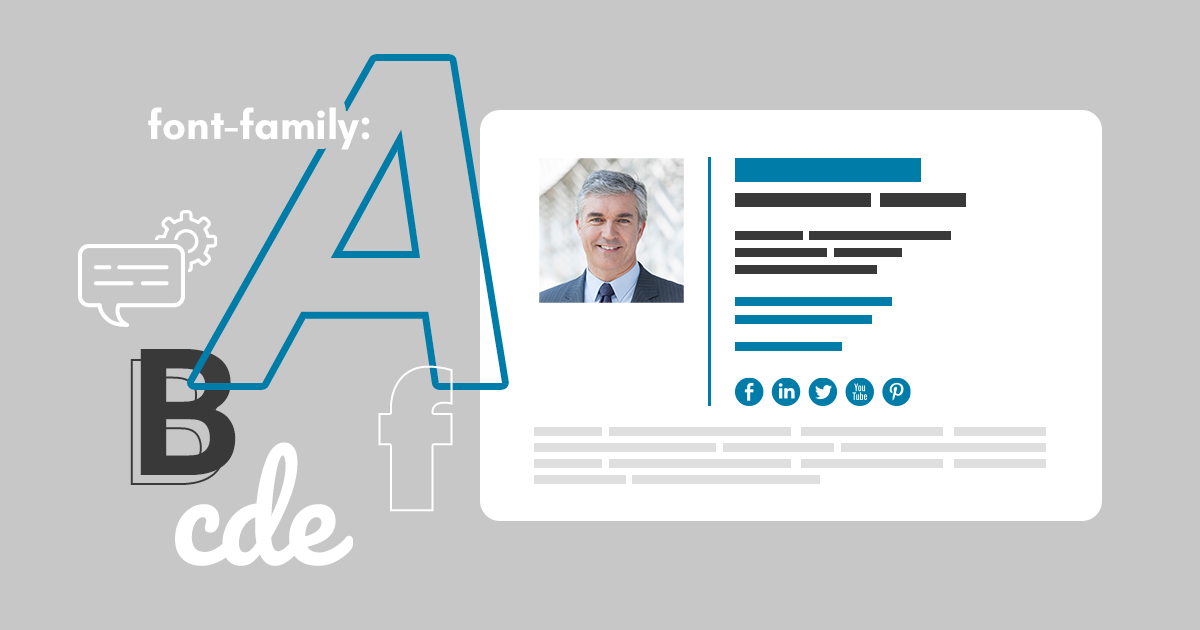
Best fonts for email signatures
To choose the best font for your email signature, you need to look for one of the web safe fonts. By ‘safe fonts,’ I mean fonts that are pre-installed on most devices. No matter if this is Windows, Mac, iPhone or Android – you can be pretty sure that the font you use in your signature is available on the recipients’ side. This will guarantee that the signature template will look just the way you see it on your screen.
There is another huge plus point for safe fonts – they are easy to read, without any decorations that would negatively impact the readability of the signature’s text. Having this in mind, here is a list of the best fonts for email signatures:
- Arial
- Verdana
- Georgia
- Tahoma
- Courier New
- Times New Roman
- Trebuchet MS
With the fonts mentioned above, you can create neat and professionally looking email signatures. Just like the one in the example below. The font used in this signature template is Arial, size 18pt for name, size 11pt for job title, and size 9pt for contact details. The signature is not only elegant, but also allows the recipient to easily find and read all necessary contact details.

But what if the font used in signatures is difficult to read? Let’s find out.
What fonts you should avoid and why
Decorative fonts
Although they are welcome in creative marketing projects, you should definitely avoid using custom or decorative fonts in email signatures. On the Internet, you can find numerous websites offering tons of fancy fonts. It is easy to download any of them and install it on your devices. But even if you have such an option, it doesn’t mean you should consider using those fonts in your email signature template.
Here are some reasons speaking for not choosing a decorative font for your email signatures:
- Bad for your brand visual identity – your email signature is actually your online business card. The way you design it can tell quite a lot about your professionalism and the character of your brand. Decorative fonts that clutter your signature or make it impossible to read should be out of the question.
- A different look on the recipient side – it is most probable that recipients of your emails don’t have your fancy font installed on their devices. As a result, the font of your choice can’t be displayed correctly or at all.
- Hard to read – most decorative fonts make the signature block unreadable. The recipient of your email should be able to easily read and find all necessary information they look for in your email signature. If they can’t quickly scan the signature for the phone number or postal address, they might get frustrated. And you don’t want that.
The template below shows how NOT to use fonts in email signatures. This decorative font makes it hard to decode all John’s contact details.

Non-web safe fonts
For email signature purposes, it is recommended to always use web safe fonts (listed above in this article). The reason behind it is their general availability on both Windows and Mac computers. All fonts beyond that list can be fonts designed specifically for Windows or Mac, which means there is a risk that a selected font won’t be supported on most recipients’ devices. If you decide to go down this path anyway, it is a good practice to set a few fallback fonts.
What are the fallback fonts and why you should use them?
Fallback fonts are not obligatory, but it is a good practice to set them in your email signatures. Why? If the font of your first choice is not available on the end user’s device, the signature will display the fallback font instead. By setting up the fallback font you ensure that your signature design will most probably provide similar experience on various email clients and devices.
How it works
In the HTML code of your signature you can add a line that lists usually two or three font names.
style="font-family: font-one, font-two, font-three;"
Where:
- Font-one: the most important one. This is a signal for the system reading your signature to always use this font if available.
- Font-two: if your first font can’t be found on the recipient’s side, then the font-two will be used in your signature instead.
- Font-three: this font will be used if the previously listed fonts are not supported on the end user’s system.
Here is an example line of code:
style="font-family: Arial, Verdana, sans-serif;"
The first font in order, Arial, is the most important one for the sender. It’s the preferred font that will be always used. The second font specified, Verdana, is the font that will be displayed when the Arial font is not supported. If the two first fonts are not found, then a default sans-serif font available on the end user’s system is used.
What fallback fonts you can use
Commonly used fallbacks are as follows:
- Serif
- Sans-serif
- Monospace
These are generic font family names, one of which should always be specified as the last option on the font list in your signature template HTML code. To learn more about the differences between serif, sans-serif and monospace font families, go to this website.
Where to specify family fonts in the signature’s HTML code?
Everywhere. I mean, in every HTML tag where you can find a text like <body>, <p>, <td>, <tr>, or <table>. This is simply the safest option. You can choose just one tag, but my first-hand experience shows that it may not be sufficient in all scenarios. See an example below of how you can ‘secure’ your signature against unexpected font changes:

As you can see, a line of code <style=”font-family: Arial, sans-serif;”> appears multiple times in the above signature template.
Email signature inspirations
If you need some inspiring examples of neat and safe email signature templates, visit this free email signature generator or signature template library. Searching through the gallery of templates may inspire you to create your own signature block that will enrich your corporate email correspondence. All email signatures listed in those resources are based on the most popular safe fonts – Arial and Verdana.

Feel free to download any of the email signature templates you find interesting and use them as your business email signatures right away. They are totally free!
Suggested reading:




Use Livvic font. This typeface is straightforward, clean, and conventional.
Thanks for the suggestion, but I wouldn’t recommend using a custom, not web safe font for email signatures – it’s bound to break for at least some of your recipients.
bookmarked!!, I like your web site!
Bonjour !
C’est très génial. Merci beaucoup !
Hi,
I am working as a graphic designer.
In my office, we have a style guide, that contains licensed font and colors that should use for corporate/advertisement materials.
Just wondering, Do I compulsorily need to use corporate licensed font for the Email Signature?
Hi Priya,
It depends on your branding policy. It is good to stick to your font style and colors across all channels. However, in emails, there is a good chance that your recipients will not be able to see a custom, licensed font. That’s why you should always add (in the HTML code of your signature) safe backup fonts which are at least somewhat similar to your custom font.
And as for the article:
Helvetica is not a web safe font! Please stop giving out bad information. It’s only preinstalled on Macs, most of the market doesn’t have it on their computers. And it’s a very expensive font.
Hello Grim,
Thanks for chiming in! Sorry for being unclear. Helvetica appeared on the list because of its high aesthetic value and broad web support. Nonetheless, it’s always a good practice to set up fallback fonts to make sure the email signature design looks well on every device. The Roboto font is considered a good Helvetica substitute, and “sans-serif” as the last fallback option takes care of every scenario possible.
I would suggest you to use Microsoft Sans Serif font. This font is simple in appearance, visibility is clear and looks standard. This looks far better than Arial and Helvetica and also available on Windows OS by default, so your signature font won’t convert into some other font on other PCs where you send emails. However, try using this font in your email signature with following formatting:
Your name (Bold, with size 10)
Designation, department, phone, email, address etc. (Simple, with size 8)
a) To call Microsoft Sans Serif better than Helvetica is just ignorant. It’s called “good taste”, look it up.
b) Great idea, use a font that isn’t supported by the Apple environment by default. It’s not like a giant portion of the marked uses Macbooks, iPhones and iPads. Many of them potential clients. And Usually those are the ones with deeper pockets.